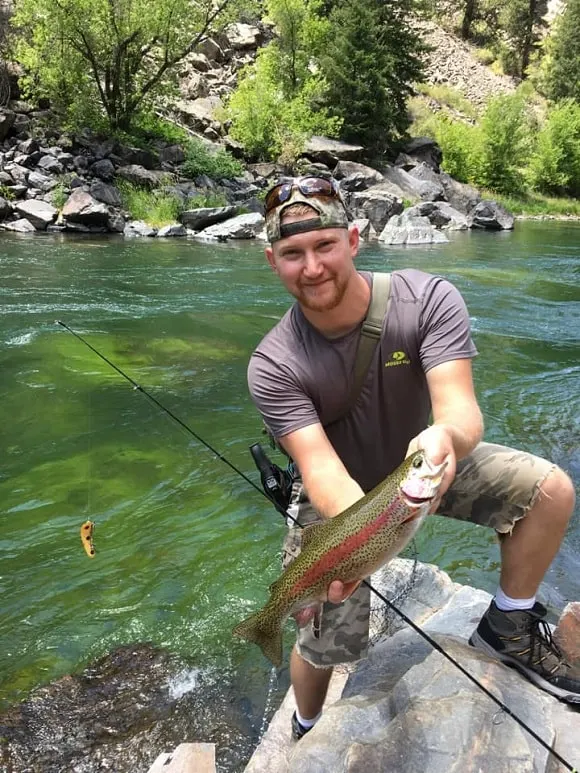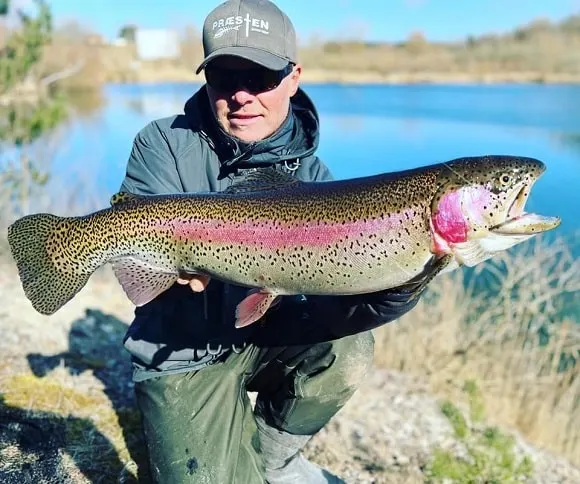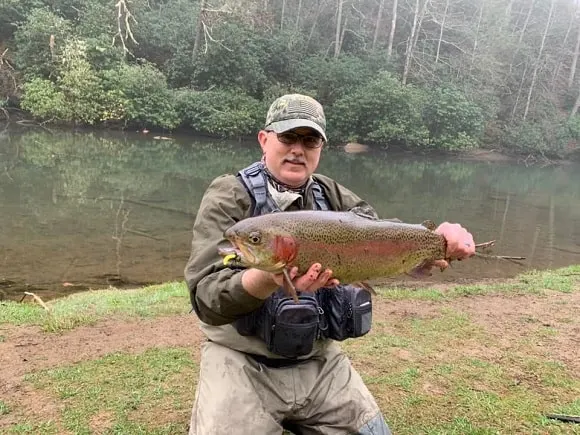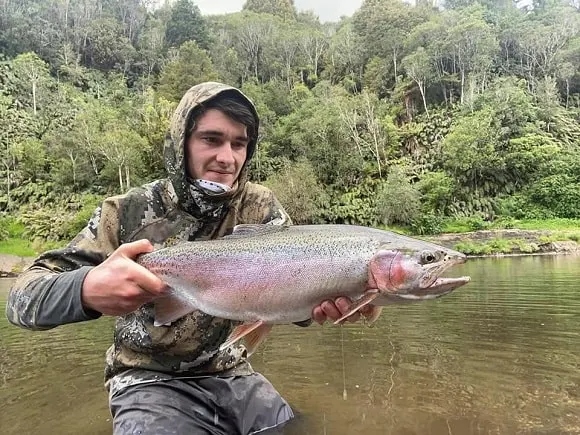Rainbow trout are fascinating fish species and a popular game fish all over the world.
As many anglers wonder about the time of their spawning, I did some research and wrote an in-depth article on this exciting topic.
Rainbow trout typically spawn in the springtime, between February and May. As their eggs need cold and well-oxygenated water, the optimal water temperature range for their spawning is 40 to 55°F (4.5 to 10°C).
Keep reading this article and find out exactly where and how deep rainbow trout are spawning, how they are spawning, and if you can catch them during the spawning season.
What Time of Year Do Rainbow Trout Spawn?
Unlike most trout and salmon species, rainbow trout (Oncorhynchus mykiss) are spring spawners.
Depending on their distribution, they typically spawn sometime between February and May in water temperatures of about 40 to 50°F.
Naturally, the northern stocks will spawn later than the southern stocks, as spring and warmer water will arrive much earlier in the more southern states.
And so, while rainbow trout found in Washington or Michigan generally spawn in March or April (and sometimes even as late as May), southern rainbow trout found in California, Arkansas, or Arizona can spawn as early as January or February.
Of course, these are mere averages, which is something to remember. Rainbow trout populations can be vast, and it’s common for several waves of spawning fish to make their way upstream.
Most rivers and streams will have one or several major runs and several smaller early and late runs, so the spawning season is most commonly stretched over several weeks or even months.
DID YOU KNOW: Rainbow trout found in the southern hemisphere will instead spawn between September and November.
Where Do Rainbow Trout Spawn?

Most rainbow trout spawn in fast-flowing waters like rivers, streams, creeks, and larger and smaller tributaries of river and lake systems.
Here they will find suitable spawning grounds and cold, well-oxygenated water, which is essential for the survival of their eggs and fry.
River-dwelling rainbows will migrate upstream until they find a suitable spawning area.
In larger river systems, they commonly seek out smaller tributaries, as they are often more suited for spawning.
Lake-dwelling rainbow trout will also seek out connected tributaries for spawning. If those tribs are too small or shallow, they tend to spawn in the areas around the in and outlets of those tributaries.
If the lake systems do not have any in or outlets, the fish will try to find shallow bay areas or, if present, attempt to spawn in straits.
However, the success rate of the spawn is typically lower in closed-off lake systems, as there is a higher risk of predation, and oxygen levels tend to be lower than in moving water.
RELATED ARTICLE: When and Where Do Brook Trout Spawn?
What Depth Do Rainbow Trout Spawn at?
Rainbow trout commonly spawn in relatively shallow waters of 1 to 3 feet.
Such shallow stretches of a river or stream often have suitable beds for the trout to lay their eggs in and, as the water flows even faster here, will be rich in oxygen.
In smaller tributaries, they can spawn in even shallower water with much higher velocity.
This makes perfect sense, as bigger predatory fish species will have difficulty getting to the eggs and fry.
What Bottom Do Rainbow Trout Prefer for Spawning?

Rainbows like to build their nests (also called redds) on bottoms with small and large gravel or small cobble substrates.
They generally avoid bottom types such as clay, silt, sand, or large cobble.
The primary reason for choosing gravel or small cobble is that such beds allow plenty of water to flow through them, which means plenty of oxygen for the eggs.
Bottom types like clay, sand, or silt, on the other hand, are pretty soft and do not let much water flow through them.
Additionally, the eggs are at risk of sinking into those soft river beds, which would eventually kill off the embryos inside them.
How Do Rainbow Trout Spawn?
If you have ever been lucky enough to witness a trout spawn, you know it’s something exceptional.
The fish moving up and down the current in perfect unison, giving life to the next generation. That, my friends, is nature at its finest!
Rainbows may spawn in spring, but they can reach their spawning grounds as early as mid or late winter. They have much work to do before the spawn commences.
Unlike other fish species, like bass, crappie, or bluegill, the rainbow females, not the males, prepare and build the nests.
A female must first find a suitable river bed section and then prepare it for the redd.
First, it will fan the gravel or cobble using its tail fin, creating a hole or depression in the bottom.
This depression will serve as the nest.
It can take a female several weeks to get one or several nests ready for action.
When the spawn is about to start, several males may approach one female, trying to mate with it.
Then, the female, which can have several males on both sides, will release the eggs into the nest.
All males will try to release their milt at the exact same time, thereby increasing the chance of passing on their genes.
The eggs commonly hatch about 3 to 4 weeks after fertilization.
DID YOU KNOW: You can easily spot the rainbow trout’s nests in very shallow river stretches. Look for bright, white, and clean spots and patches among the gravel!
Can You Catch Rainbow Trout During the Spawn?

The trout will be in the rivers or tributaries for a prolonged time during the spawning season, which gives you, the angler, an excellent window of opportunity.
Rainbow trout will feed before, during, and after the spawn, so catching them this time of year is pretty easy, especially during the bigger runs when plenty of fish are around!
Personally, I would always choose a catch-and-release approach for the big females during the spawning season. After all, they carry the next generation of rainbows in their stomachs!
But of course, that’s up to every angler and each water’s respective rules and regulations.
It’s just something to remember if you appreciate and support sustainable fishing.
On the other hand, taking home a few male pre or post-spawn rainbows isn’t a big deal in my book!

So how do you best catch them during the spawn?
Several technics promise good results, and often, the fish won’t be extremely picky about the bait presented in front of them.
That said, there can also be plenty of days during which it feels absolutely impossible to catch a rainbow trout! You never know until you know.
On the good days, you can try your luck with both your spinning and fly rod.
Smaller spinners, spoons, jigs, or crankbaits are good lure choices for rainbow trout.
Additionally, both dry and wet flies, as well as streamers, can work really well.
PRO TIP: Remember to match the hatch. That’s usually a recipe for success on the busy trout rivers!
You can also target them with a simple slip bobber rig.
This one is my personal favorite for migrating trout! Seeing that bobber go down in the current is really exciting.
It’s probably also the most suited fishing method for beginners, by the way.
You can put a wide variety of baits on your hook; worms, leeches, insects, minnows, shrimps, fish eggs, you name it. They’ll eat almost anything when the bite is on!
PRO TIP: Many anglers swear by trout and salmon eggs. These work especially great in rivers that have other trout and salmon types. Rainbows like to munch on other species’ eggs, so using those as bait can be a real game changer!
How Many Eggs Do Rainbow Trout Lay?
Hatchery management and research have shown that female rainbow trout can lay approximately 1,000 eggs per pound of body weight.
This translates into the following average data:
| Weight of Female Rainbow Trout | Approx. Number of Eggs |
| 2lb | 2,000 |
| 5lb | 5,000 |
| 10lb | 10,000 |
| 15lb | 15,000 |
| 20lb | 20,000 |
| 30lb | 30,000 |
| 40lb | 40,000 |
RELATED ARTICLE: What Time of Year Do Brown Trout Spawn?
Do Rainbow Trout Spawn More Than Once a Year?

Rainbow trout will only spawn once a year, which isn’t surprising, given that most fish undergo a long and complicated journey to reach their spawning grounds.
However, it has been observed that females can have several spawning sessions during one season, meaning they will only deposit some of their eggs into one nest.
They may deposit some of their eggs and then move on to the next redd, where they will mate with another male.
Related Articles
- What Is the Maximum Size of Rainbow Trout?
- What Is the Difference Between Rainbow Trout and Steelhead?
- Lake Trout vs. Rainbow Trout (How Are They Different?)
Featured image courtesy of Steve Maloney

